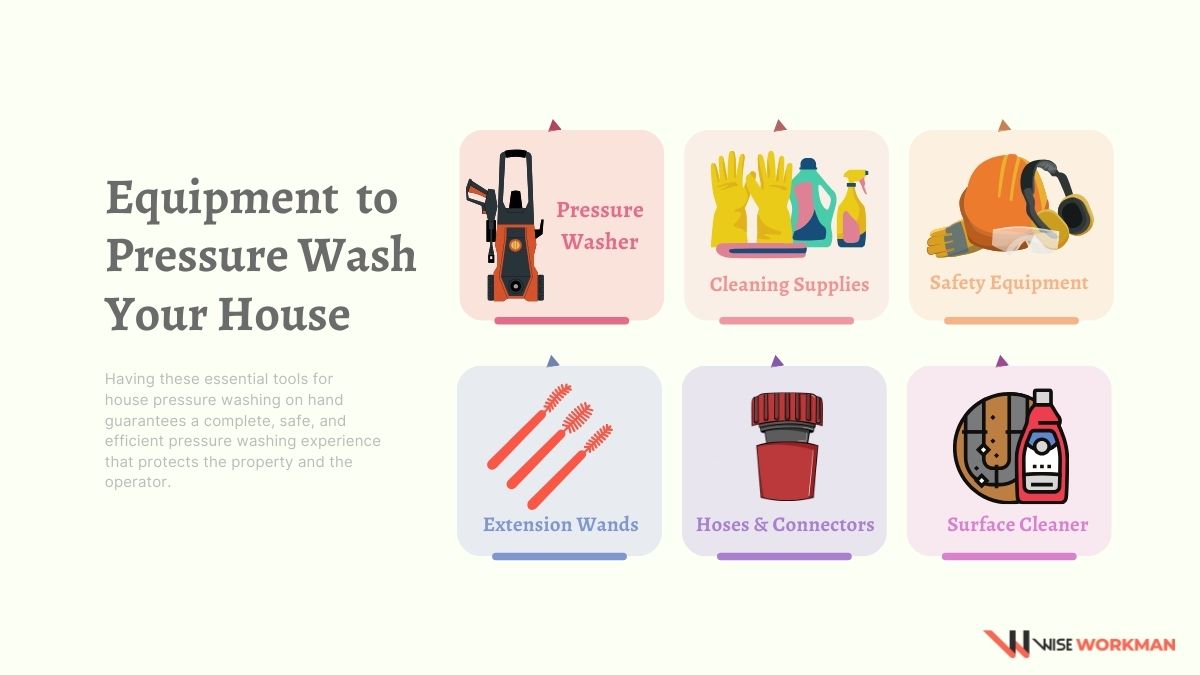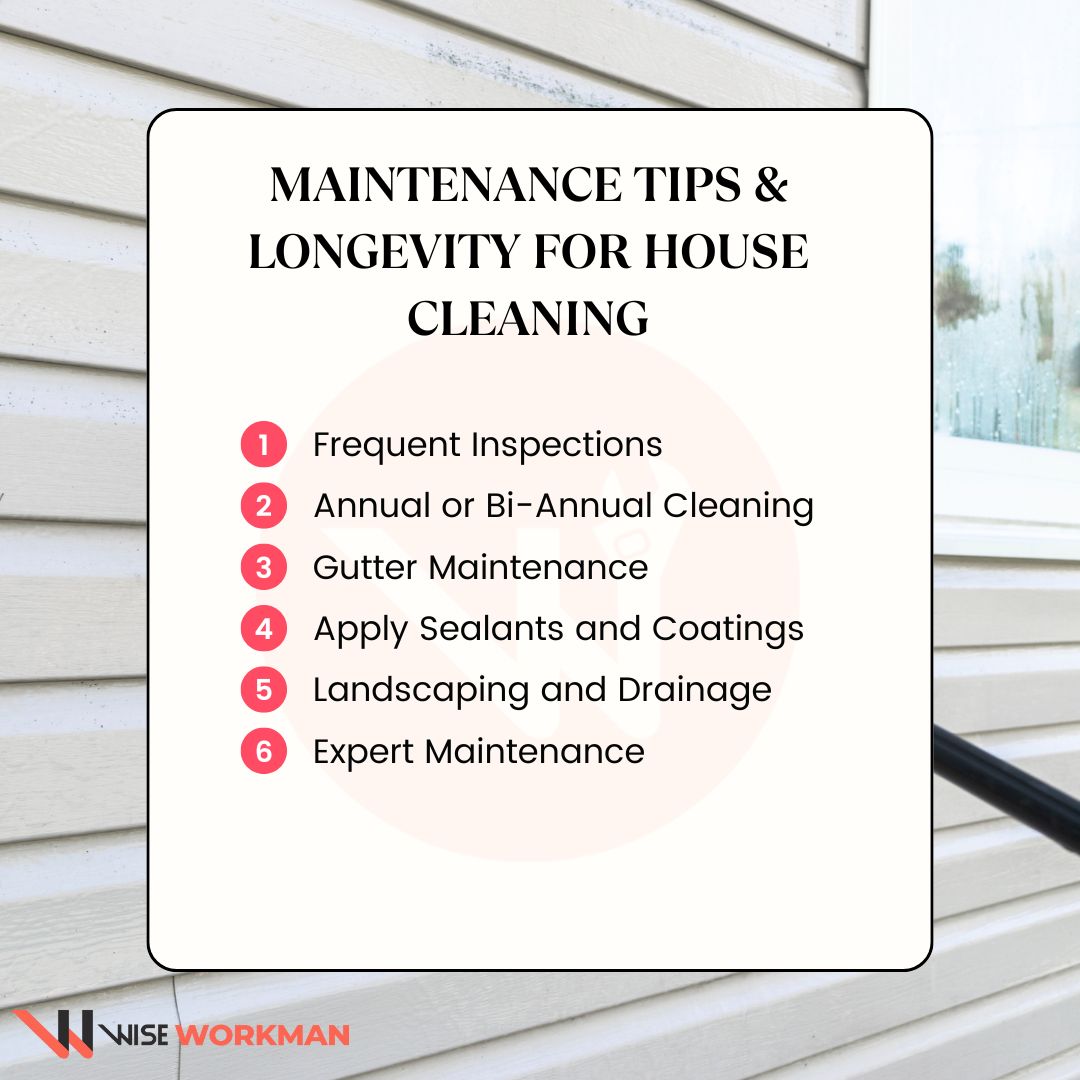You may be wondering how to pressure wash a house.
Pressure washing is a great way to maintain the outside of your house, and there are many reasons why this is important. Your property's curb appeal and general aesthetics are influenced by the outside, which makes an initial impression.
Frequent upkeep, such as pressure washing, helps protect the external finish by avoiding accumulating dirt, grime, mold, and mildew, which can erode surfaces over time.
Pressure washing revitalizes surfaces, including siding, decks, driveways, and fences, by efficiently removing accumulated debris, stains, and biological development.
It makes your house look better by giving paint or other surfaces that have become dull from exposure to the elements their original brightness back.
Furthermore, pressure washing helps maintain structural integrity and create a healthier living environment by removing mold, mildew, and other pollutants.
Proactive care enhances the aesthetic appeal of your home and adds to its value. It also extends the life of external materials, saving money over time.
Let us now walk you through everything you will need to know about pressure washing your house!
In order to ensure safe pressure washing, Important safety measures must be taken:
Protective Gear: Wear the proper protective gear, such as goggles or safety glasses to protect your eyes from debris, gloves to protect your hands, non-slip shoes, and earplugs if you're working loud machinery.
Additionally, to protect yourself from high-pressure water injuries, think about donning clothing that protects exposed skin.
Examine the equipment manuals: Go over the pressure washer's operating instructions. Be aware of its characteristics, safety precautions, and suggested operating methods to avoid mishaps or abuse.
Pressure Settings: Configure the pressure settings based on the surface that needs to be cleaned.
To avoid damaging sensitive surfaces, use lower pressure settings; higher pressure levels are appropriate for surfaces that are more resilient. Always begin at the lowest pressure possible and gradually raise as necessary.
Appropriate Nozzle Usage: Apply the right nozzles to various surfaces and jobs. For more sensitive surfaces, use wider-angle nozzles to distribute pressure uniformly and avoid damage.
Distance and Angle: To avoid harm or damage, stay a safe distance away from the surface being cleaned, usually two to three feet. To effectively clean without harming the surface, hold the nozzle at a constant angle.
Environmental Considerations: To avoid harming the environment, make sure that water is disposed of properly. Wastewater should not be directed into natural water bodies or storm drains.
Ensuring safety in house pressure washing can help you prevent damage to your property or compromising your own safety.

A safe and effective cleaning process requires a variety of equipment, which is why the following essential house pressure washer tools are so important.
Having these essential tools for house pressure washing on hand guarantees a complete, safe, and efficient pressure washing experience that protects the property and the operator.
In order to ensure that pressure washing is done safely and effectively while protecting delicate objects or regions, getting your space ready for pressure washing is necessary: the area must be prepared before pressure washing.
Debris and Object Removal: Start by clearing the area that needs to be cleaned of any obstructions, debris, or loose objects. In addition to ensuring a more seamless operation, clearing the area minimizes potential damage from debris that the pressure washer may launch.
Moving Dangerous Goods: Remove fragile ornaments, potted plants, outdoor furniture, and decorative pieces from the cleaning area. Move them to a secure distance to shield them from any unintentional harm caused by the high-pressure water.
Sensitive Area Protection: Cover outlets, vents, fragile surfaces, and items that are easily damaged by water. To shield these weak areas from impact or water seepage, use specialized coverings, plastic sheeting, or waterproof tarps.
Securing Windows and Doors: Tightly shut windows and doors to keep water out of interior areas. Think about sealing them with waterproof materials for further security.
You may minimize potential property damage while creating a safer pressure-washing environment by ensuring area readiness, moving fragile things, and covering sensitive areas.
For pressure washing a variety of surfaces and jobs in an efficient and safe manner, picking the best pressure and nozzle for pressure washing is essential.

Surface Evaluation: Examine the substance and state of the surface. Lower pressure levels are preferable for sensitive surfaces like wood or siding in order to avoid damage. Increased pressure could be appropriate for harder surfaces like brick or concrete.
Optimal Pressure Settings: Change the pressure levels on the pressure washer based on the needs of the surface. For surfaces like wood or cars, lower pressure settings—typically between 1200 and 1500 PSI—are best.
For concrete or masonry, medium pressure settings—roughly 2000 to 3000 PSI—work effectively. Higher pressures of three thousand PSI or more could be required for labor-intensive jobs like paint removal or stains that won't go away.
Selecting the Right Nozzle: Various nozzles regulate the pressure and spray pattern. The spray angles of nozzle tips are indicated by color coding, such as 0 degrees for concentrated spray and 40 degrees for wide spray.
For softer surfaces, use nozzles with wider angles; for more stubborn stains or greater cleaning force, use nozzles with narrower angles.
Pressure levels and nozzles should be properly matched to particular surfaces and tasks in order to ensure effective cleaning without risk of harm.
Here is a comprehensive guide to house pressure washing and safe surface cleaning:
Preparation: Prepare by clearing the space, moving breakables, covering delicate spots, and inspecting the surfaces.
Pick Out Your Gear: Assemble the extension wands, safety equipment, cleaning supplies, pressure washer, and suitable nozzles.
Link Up the Equipment: Hoses, nozzles, and connectors should be firmly attached. If necessary, fill the detergent tank.
Start at the Top: Take the tallest sections first, such as the gutters or roof. Make use of wide-angle nozzles and lower-pressure settings. To prevent streaks, work in parts and move carefully.
Walls and Siding: Vary pressure according to surface composition. For siding, use a nozzle with a wider angle. Keep a safe distance to avoid getting hurt.
Windows and Doors: Use the proper nozzles and low-pressure settings for windows and doors. Steer clear of spraying directly onto caulk or sealants.
Final Rinse: Make sure all of the detergent is gone by rinsing from top to bottom.
Inspection and Drying: Let surfaces air dry. Check for any possible damage or overlooked areas.
By following this house pressure washing procedure, you may pressure wash your property safely and thoroughly, leaving clean surfaces behind while also protecting your investment.
With pressure washing, several techniques and appropriate detergents can be used to eliminate stains and mold. Here are some stain-cleaning solutions and mold-removal techniques:
Stain Removal: Before pressure washing, apply a degreaser or specialized oil stain remover to surfaces with oil or grease stains. It may be necessary to use harsher chemical solutions developed for particular stain types to remove stubborn stains like tire marks or rust.
Mold and Mildew Removal: Use a mold and mildew cleanser designed for pressure washing that contains components like bleach or oxygenated compounds.
After applying the solution to the impacted areas, let it sit for a few minutes before using the pressure washer to rinse it out. Make sure to dilute the product as directed by the manufacturer to avoid damaging the surface.
Environmentally Friendly Options: When removing mold and mildew, especially on more fragile surfaces, think about using environmentally friendly cleaning products like hydrogen peroxide or vinegar.
These solutions may need more than one application to remove stubborn stains, but they are gentler on the environment.
Always wear safety gear, test a small area before applying the detergent fully, and follow the product directions to make sure the detergent you choose eliminates stains, mold, and mildew without harming the surface.
Following a house pressure wash, a few crucial post-wash procedures guarantee the longevity of the equipment and appropriate water disposal, keeping the surroundings safe and clean.
Pressure Washer Maintenance: Disconnect the hoses and turn off the pressure washer. To avoid damage and corrosion, clean the nozzles and filters, flush any leftover detergent from the system, and store the equipment correctly.
Surface Inspection: Examine the cleaned surfaces for any places that were overlooked or for any possible harm that may have occurred during the process. Any spots that still need cleaning or repairs should be touched up or addressed.
Water Disposal: Make sure you conduct proper water disposal. Wastewater should not be directed into natural water bodies or storm drains.
In order to prevent environmental contamination, dispose of wastewater according to local legislation, to take into account options such as draining into sanitary sewer systems or utilizing an appropriate filtration system.
Cleaning: Replace moved things, take off coverings from delicate places, and properly dispose of waste. If necessary, rinse the surrounding areas to get rid of any remaining cleaning solution.
You may preserve equipment functionality, save the environment, and guarantee a comprehensive wrapping up for your house pressure washing according to these post-wash procedures.

Take into consideration these long-term suggestions to get exterior care benefits and preserve your home's exterior after pressure washing:
By implementing these maintenance strategies, you can achieve house appearance preservation and enhance your home's exterior aesthetics while protecting it from potential damage.
Before you start pressure washing your house, you should use a cleaning solution to remove any dirt or grime. You can use a commercial cleaning solution or make your own with a mixture of water and a cleaning agent like dish soap or laundry detergent. Be sure to follow the manufacturer's instructions for the cleaning solution and test it on a small area of your house before applying it to the entire surface.
Pressure washing can be safe if you follow the proper safety precautions. Wear protective gear like safety goggles and ear protection to protect yourself from flying debris and loud noises. Also, be sure to use the appropriate pressure setting for your house's exterior material, as using too high of a pressure can cause damage.
Before you start pressure washing, move any outdoor furniture, decorations, or plants away from the house. Cover any electrical outlets, light fixtures, or other areas that may be susceptible to water damage. Also, be sure to close all windows and doors to prevent water from entering your home.
While bleach can be an effective cleaning agent, it can also be harmful to your house's exterior and surrounding plants. Instead, use a cleaning solution specifically designed for pressure washing, or make your own solution with a mild detergent.
If you don't have a pressure washer, you can still clean the exterior of your house with a bucket of soapy water and a scrub brush. Be sure to rinse the surface with a hose after scrubbing to remove any remaining soap residue.
Always start with a low-pressure setting and work your way up as needed. Hold the pressure washer nozzle at a 45-degree angle to the surface to prevent damage. Also, be sure to keep the nozzle moving to avoid leaving marks on the surface. Finally, be sure to follow the manufacturer's instructions for your pressure washer and cleaning solution.
The house pressure-washing conclusion is that a house's exterior restoration process involves several important steps that come together to create a dramatic change that enhances the appeal of a recently pressure-washed and cleaned home.
First, a thorough inspection is conducted to identify any areas that need attention. Next, specific cleaning solutions are applied to ready surfaces. The main event, pressure washing, removes deeply ingrained dirt and mildew, revitalising the outside while protecting it from further damage.
This painstaking technique's visually striking exterior transformation highlights the attractiveness of a well-kept property. Beyond the beauty of a clean, pressure-washed home, the benefits include boosting the property's value and creating a healthier living environment by getting rid of allergens.